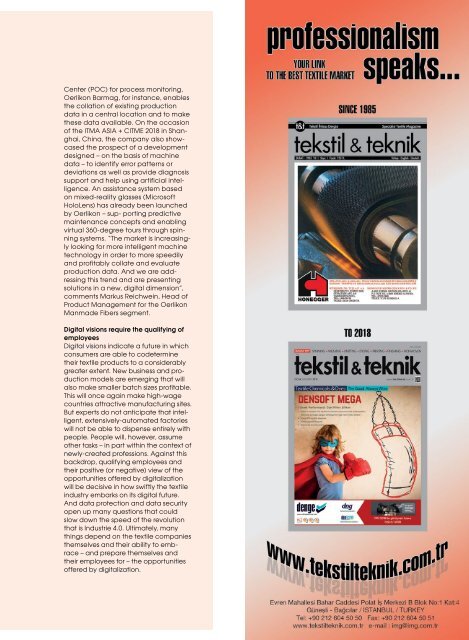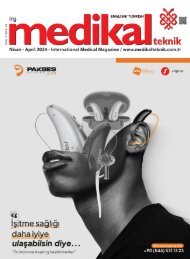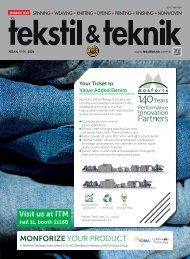Create successful ePaper yourself
Turn your PDF publications into a flip-book with our unique Google optimized e-Paper software.
Center (POC) for process monitoring,<br />
Oerlikon Barmag, for instance, enables<br />
the collation of existing production<br />
data in a central location and to make<br />
these data available. On the occasion<br />
of the ITMA ASIA + CITME <strong>2018</strong> in Shanghai,<br />
China, the company also showcased<br />
the prospect of a development<br />
designed – on the basis of machine<br />
data – to identify error patterns or<br />
deviations as well as provide diagnosis<br />
support and help using artificial intelligence.<br />
An assistance system based<br />
on mixed-reality glasses (Microsoft<br />
HoloLens) has already been launched<br />
by Oerlikon – sup- porting predictive<br />
maintenance concepts and enabling<br />
virtual 360-degree tours through spinning<br />
systems. “The market is increasingly<br />
looking for more intelligent machine<br />
technology in order to more speedily<br />
and profitably collate and evaluate<br />
production data. And we are addressing<br />
this trend and are presenting<br />
solutions in a new, digital dimension”,<br />
comments Markus Reichwein, Head of<br />
Product Management for the Oerlikon<br />
Manmade Fibers segment.<br />
Digital visions require the qualifying of<br />
employees<br />
Digital visions indicate a future in which<br />
consumers are able to codetermine<br />
their textile products to a considerably<br />
greater extent. New business and production<br />
models are emerging that will<br />
also make smaller batch sizes profitable.<br />
This will once again make high-wage<br />
countries attractive manufacturing sites.<br />
But experts do not anticipate that intelligent,<br />
extensively-automated factories<br />
will not be able to dispense entirely with<br />
people. People will, however, assume<br />
other tasks – in part within the context of<br />
newly-created professions. Against this<br />
backdrop, qualifying employees and<br />
their positive (or negative) view of the<br />
opportunities offered by digitalization<br />
will be decisive in how swiftly the textile<br />
industry embarks on its digital future.<br />
And data protection and data security<br />
open up many questions that could<br />
slow down the speed of the revolution<br />
that is Industrie 4.0. Ultimately, many<br />
things depend on the textile companies<br />
themselves and their ability to embrace<br />
– and prepare themselves and<br />
their employees for – the opportunities<br />
offered by digitalization.

















